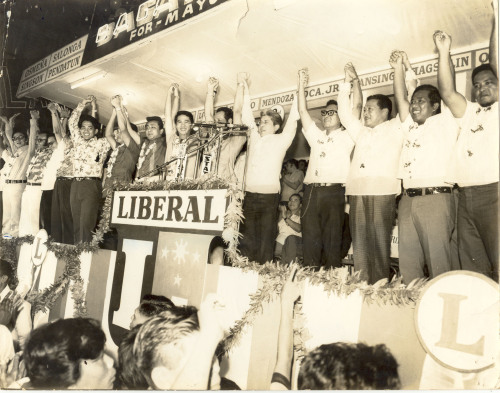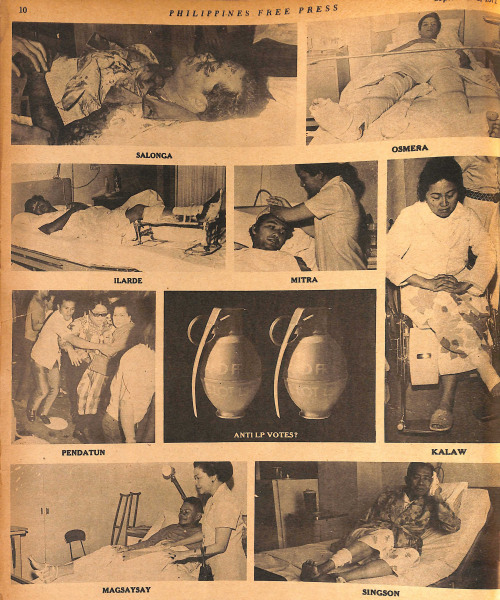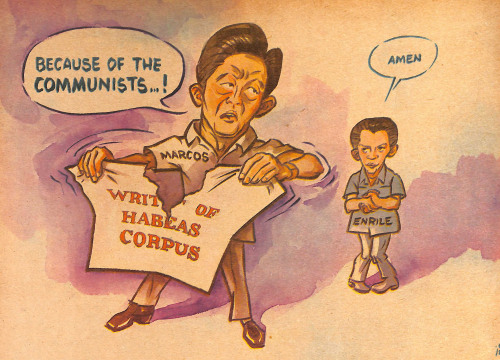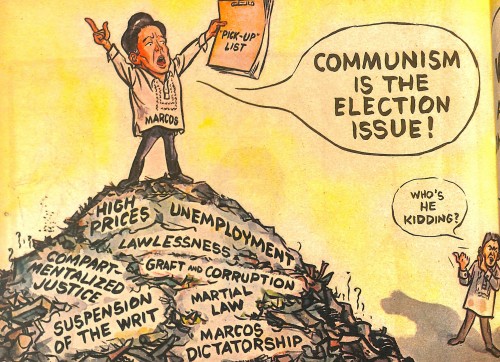Pawns in Cities lobbed with Bombs: Events leading to the Plaza Miranda Bombing
Like pieces on a chessboard, Ferdinand Marcos took efforts to set the board, to place his pawns and move them at will, all towards his endgame. This took great risks and a series of tactical and carefully weighed decisions. It required knowing the rules, and the loopholes in it, and how to make use of these loopholes fully to his advantage. Perhaps that’s one of the things that historians hesitate to credit him for. But I give him credit for this, if only to warn succeeding generations of how volatile and fragile democracy is, and how weak our democratic institutions are. As with the previous posts I have written, I have shown through documents and reportage that Marcos was a product of the same generation that came out of the Second World War. His rise was unprecedented but was not unlikely. He was the logical conclusion of a system and a culture prevalent in the country. Hence, it is of great benefit that we look into the rise of the Marcos dictatorship in all its complexity and nuances.
In the diary entries of President Marcos, it was clear (whether delusional or not) that he saw himself as the savior of the republic in grave danger.
“As I listen to the remarks about the infiltration of media and the need for a strong leadership I cannot but wonder inside me if the crucial hour of decision is not fast approaching, when I must determine whether the irremediable step of martial law is the only course of action if we were to save our republic. But I am decided that there must be massive sabotage or an overt attempt to overthrow the government before I declare martial law. Thus the decision will be better understood and supported by the people and by foreign governments.”
Whether this “sabotage” or an “attempt to overthrow the government” were threats from outside or government-created, I would let the reader be the judge. Marcos continues:
“The silent conspiracy against our republic is joined in by well-meaning men who use the inequities of our society and despair that they can ever be rectified except by radicalism and violence. For there are many valid grounds of grievance as the rich and powerful disregard or are insensitive to the dreams or even the frustrations and pains that torture the masses of our people.”
He then reiterates his plans:
“We must refashion this society.
We must wage our own revolution.
The concept of ownership must be changed so the small people have a chance. All the crooks in government must be booted out. The media must be geared to development and progress, not to destruction and retrogression.”
The threats in his mind were the “oligarchs”, the “communists” and the unruly media. Marcos hated criticism with a passion. He took a great liking of lambasting the media publicly or privately for criticizing his policies.
“…Freddie Elizalde [of Manila Broadcasting Company] showed me a copy of an editorial which Chino Roces [Manila Times] wanted to be pooled by all the newspapers castigating me and asking for my resignation and that of the cabinet. For good measure the editorial included the Vice-President. It was opposed by Freddie [Elizalde] and [Sebastian] Ugarte [of Philippines Herald]. And Teddy Locsin [of the Philippines Free Press] opposed the demand for resignation.
What a ridiculous spectacle Chino Roces is making of himself. He is supposed to have said that I engineered the drivers strike and am leading to a declaration of martial law as there will be violence tomorrow and in the days to come, and he predicted that at least ten men would be killed tomorrow…
…The timetable is being pushed too fast by the leftists. It may be earlier than we think.
Marcos wrote about his allies in Congress who encouraged him to push the plan for Martial Law.
The congressmen close to me, Cong. Cojuangco, Frisco San Juan, Ali Dimaporo, Jose Aspiras, [Constantino] Navarro [Sr.], Lucas Canton, Roque Ablan all proposed for the use of my emergency powers. “We cannot understand why you are so patient. Do not wait until we are completely debilitated and the people is against us. It will be too late. One swift blow and we remove the cancer from our society,” they all said.
I could only answer that it may be sooner than we think…
Meanwhile, Vice President Fernando Lopez had been very vocal against corruption in government. As Secretary of Agriculture in Marcos’ Cabinet, he spoke his own mind, and did his own programs—at times clashing with Marcos. Marcos knew early on that he couldn’t control the man, especially that Lopez was also a member of the “oligarchy” he detested. In January 1971, Marcos blamed him for slowing down his “reforms” and programs. This led to Lopez’s resignation from Cabinet on the 14th. (Read about the background of the Marcos-Lopez feud here).

*Before the campaign began in 1969, Fernando Lopez made a courtesy call on President Marcos (photo above), where he was persuaded by Marcos to run as his running mate for the position of Vice President. Both of them won in the 1969 elections. Source: National Library of the Philippines
Six days after, the Liberal Party came out with a full-page article expressing its position against the imposition of “martial law”, threatening that they would not attend sessions if it was imposed. It read:
“We believe that a declaration of Martial Law or the suspension of the privilege of the Writ of Habeas Corpus is intended to eliminate all oppositions; to suppress dissent; free speech, and free press, all civil liberties, and to install a fascist dictatorship throughout the land.”
This was a sign that the rumors of martial law, vocalized by Marcos as early as 1969, had sown fear and revulsion in the country.
Then the city bombings began. On January 22, one of the first of many bombings occurred in the city. The Manila headquarters of the U.S. owned oil companies Esso and Caltex exploded. Again, Marcos blamed the Communists for this. This would be the first of many, reaching its zenith days before the declaration of Martial Law in 1972.
The next day, the Philippines Free Press came out with a scathing editorial against the administration:
The demonstrations held so far in the Philippines against the government and the violence that has marked some of them are nothing compared with the violent expressions of protest in the United States. President Nixon has yet to speak of the possibility of suspending the writ of habeas corpus or imposing martial law on the American people. If he were to do so, is there any doubt he would be impeached and ousted from office? Why does President Marcos keep talking of the possibility of suspending the writ or imposing martial law on us? The solution for the problem of social unrest in the Philippines is not suspension of the privilege of the writ of habeas corpus or the imposition of a military dictatorship on the Filipino people but reform. Regain the confidence of the people. Stop corruption and the waste of the nation’s resources in senseless extravagance. Set a moral example. Be a true President of the Filipino people. Is that too difficult to do?
Must the writ be suspended?
Must there be martial law?
Writer Napoleon Rama of the Free Press described this alarm on martial law, spreading “throughout the breadth and width of the nation.”
By this time, Marcos’ unpopularity have significantly risen. Take a look at the survey conducted at the time by the Research Center Philippines, an independent polling organization. It initiated a survey of the people’s perspective of the Marcos administration on February 10, 1971. By February 19, they have the results. The questions were insightful, and the answers in favor of Marcos were dismal.
“Are you in favor or against amending our Constitution to allow President Marcos to run for a third term?”
- 85% against. 8.8% in favor.
“There has been a talk of putting Mrs. Marcos, the wife of our President as a candidate for President next time. In your opinion, is this a good idea or not a good idea?”
- 82.7% said it was not a good idea. 11% said otherwise.
“Do you approve or disapprove of the way President Marcos is running the affairs of our government at present?”
- 67.3% disapproves, 20.3% approves
“In his State of the Nation Address last January 25 [1972], President Marcos said he will devote his time and efforts from now on to the welfare of the people. Which of the following statements is closest to your opinion about what he said?”
- 45.9 % said it will become another one of his broken promises. 25.6 % said he is sincere but he can do little to improve living conditions.
And with all the violent protests going on, Marcos knew that his time was running out. In June 1971, the Constitutional Convention tasked to amend the 1935 Constitution convened, with the 320 delegates, elected in November of the previous year. The Convention was headed first by former President Carlos P. Garcia, but due to his unfortunate and untimely passing three days after, he was replaced by former President Diosdado Macapagal, one of Marcos’s key opponents.
And yet, soon after, unconfirmed allegations of bribery were rumored among the delegates so that they would vote in favor of a parliamentary form of government in the new Constitution, where Marcos would become Prime Minister. This was enough for public opinion to rise against the conduct of the convention.

*Liberal Party President and Senator, Gerardo “Gerry” Roxas endorses the LP slate for the City of Manila, led by Ramon Bagatsing, minutes before the bombing, August 21, 1971. Source: Gerry Roxas Foundation
Meanwhile, at Plaza Miranda on August 21, 1971, during the Liberal Party’s miting de avance for the upcoming midterm Legislative Elections at Plaza Miranda in Quiapo, an event shook the country. Writer Edward Kiunisala wrote:
“August 21, at about 9:15 p.m., barely seconds after the Liberal Party candidates for Manila’s elective posts had been officially proclaimed on jam-packed Plaza Miranda, two fragmentation, combat grenades suddenly exploded in what proved to be the most villainous, outrageous and shameful crime in the annals of local political violence. It was a night of national tragedy and infamy as democracy—Philippine style—bared itself in all its terrifying ugliness.
For one dark, demented, damning moment of history, time stopped as tens of thousands of televiewers all over the country watched in utter horror the mass slaughter at Plaza Miranda. Miraculously, all top Opposition leaders who were there managed to cheat death. But not one of the eight LP senatorial candidates escaped injury. Sen. Jovito Salonga, as of this writing, is still fighting for his life, although the others were already pronounced “out of danger.””

*Free Press spreadsheet of photos of injured LP leaders in the Plaza Miranda Bombing. Source: Presidential Museum and Library.
Investigations revealed that two people who were earlier employed as aide for Mayor Antonio Villegas of Manila, threw grenades on the rally. Among those who were hurt were Jovito Salonga, Gerardo Roxas, and Sergio Osmeña Jr., all of whom were prominent opposition leaders against Marcos. President Marcos blamed the Communists for the bombing, but public opinion, and many of the LP leaders believed Marcos was the culprit. Moreover, after the explosion, President Marcos suspended the Writ of Habeas Corpus nationwide (citizens can be imprisoned without a trial or fair hearing), citing subversive elements in rebellion.

*Free Press editorial cartoon on August 1971. Source: Presidential Museum and Library.

*Lakasdiwa, a leftist group, stages a march against the suspension of the Writ of Habeas Corpus, sometime in September 1971. Source: FQS Library.
One of those injured, guest candidate Senator Eva Kalaw, was interviewed by the Free Press, days after the bombing where she advised the people “to wait two more years.”
If they agitate now, it will be used as an excuse for martial law. But if we wait quietly until the end of Marcos’s term, then we can have the government of our choice, the people’s choice.
This was what Kalaw pointed out when she delivered her speech on the Senate floor the following day, where she pointed out that the suspension of the Writ nationwide was “uncalled for” because the bombing was just in Plaza Miranda. Earning Marcos’s ire on the matter, Marcos said, “I appeal to the Liberal Party to segregate communist conspiracy from politics. Otherwise, I will be compelled to conclude that the Liberals are protecting Communists.” But Marcos wasn’t convincing.

*Free Press editorial cartoon on November 1971. Source: Presidential Museum and Library.
By November, the Midterm Legislative Elections was in full swing. Marcos kept on insisting that the issue was Communism, but the people weren’t persuaded. In an unprecedented win, the Liberal Party won six of the eight seats in the Senate in that election. But the opposition was still outnumbered in the 24-seat Senate, with only 9 Liberals opposing 15 Nacionalistas.
Marcos wasted no time in making his views known. Aside from increasingly frequent visits to military encampments, Marcos would also deliver speeches to around 1,000 newly elected local government officials on December 11, 1971, in a bid to convince them that Communism was the real threat.
On December 30, 1971, Rizal Day, Enrile handed to President Marcos a brown envelope, which contained the following documents:
1. Draft of a proclamation to declare Martial Law
2. Drafts of seven General Orders.
3. Drafts of seven Letters of Instruction
4. Draft of his [Enrile] appointment as deputy commander-in-chief of the Armed Forces of the Philippines.
Was the suspension of the Writ and its restoration upon people’s clamor, a specter of things to come? The legal documents for Martial Law were ready as early as 1971. And Marcos had tested the feasibility study he secretly initiated, on an actual political scenario. And upon the suspension of the Writ, he had seen the reaction of the political establishment. With a few tweaks, one could see how he was able to pull it off in September 1972.
The Road to Martial Law is a series of blog posts documenting the unprecedented rise of a Filipino dictator and the sudden death of Philippine democracy with the declaration of a nationwide Martial Law via live television on September 23, 1972.
The Road so far:
- It Takes a Village to Raise a Dictator: The Philippines Before Martial Law
- Truth or Dare?: Marcos during WWII
- The Turbulent ‘60s and Marcos’ Ascent to Power
- The Gathering Storm: Beginnings of the Communist insurgency and Moro secessionism in the ‘60s
- The First Quarter Storm of 1970: The Philippines on the Brink
- A Plan for the Endgame: Plots, Protests, Scandals and Assassinations
- Pawns in Cities lobbed with Bombs: Events leading to the Plaza Miranda Bombing
- Hijacking Democracy: The Mood before the Declaration of Martial Law
- September 21, 1972: When Martial Law Had to Wait for One More Day
- Like a Thief in the Night: Martial Law Implemented on September 22, 1972
- The Long Night Begins: Martial Law Announced on Live Television, September 23, 1972
- A Mere Scrap of Paper: The Constitutional Convention Hijacked under Martial Law
- The Final Blow: A compromised Supreme Court legitimized Martial Law
- Road to Martial Law Redux: A Conclusion to a Series
Photo Slides Above:
(1) Plaza Miranda Bombing became front cover news in the Philippines Free Press Magazine, September 4, 1971. Courtesy of the Presidential Museum and Library
(2) Minutes after the explosion at Plaza Miranda, people were wrought with panic, August 21, 1971. Courtesy of the Gerry Roxas Foundation.
(3) After the Bombing, President Marcos accused the injured LP of protecting communists, after they accused Marcos of masterminding the bombing. This exchange was an inspiration for this Free Press editorial cartoon. Courtesy of the Presidential Museum and Library
(4) A month after the bombing, injured members of the Liberal Party were interviewed on live television. Courtesy of the Presidential Museum and Library.
Acknowledging the help of my colleagues: history researchers Sasha Wong, Jad Arcinas, Coli Cardeño and Sir @mlq3.
Bibliography
___, The Philippine Electoral Almanac, Revised and Expanded. Manila: Presidential Communications Development and Strategic Planning Office, 2015.
___, “Political War and Martial Law,” Philippines Free Press, January 23, 1971, link.
Enrile, Juan Ponce. Juan Ponce Enrile: A Memoir. Quezon City, ABS-CBN Publishing Inc., 2012.
Gleeck, Jr., Lewis E. President Marcos and the Philippine Political Culture. Manila: Loyal Printing, Inc., 1987.
Kalaw, Eva. A Political Journey. Pasig City: Anvil Publishing, Inc., 2008.
Kiunisala, Edward, “The Outrage,” Philippines Free Press, September 4, 1971, link.
Martinez, Manuel. The Grand Collision: Aquino vs. Marcos. Quezon City: M. F. Martinez, 1987.
Marcos, Ferdinand. “January 1, 1971,” Marcos Diary.
Marcos, Ferdinand E., “January 2, 1971,” Philippine Diary Project, link.
Mijares, Primitivo. The Conjugal Dictatorship of Ferdinand and Imelda Marcos. San Francisco: Union Square Publications, 1976.
Rama, Napoleon, “Will there be martial law?” Philippines Free Press, January 30, 1971, link.
Rempel, William. Delusions of a Dictator: The Mind of Marcos as Revealed in His Secret Diaries. Boston, MA: Little, Brown & Co., 1993.
49 Notes/ Hide
 sintensya liked this
sintensya liked this  shinynewtoysyndrome liked this
shinynewtoysyndrome liked this the-martial-law-thingy reblogged this from indiohistorian
caligvlas reblogged this from indiohistorian
 punnymoi liked this
punnymoi liked this  squeakystuffedparrot liked this
squeakystuffedparrot liked this  anexperimentallife reblogged this from indiohistorian
anexperimentallife reblogged this from indiohistorian yasu-gyaru liked this
queerhistorymajor reblogged this from indiohistorian
lmpressionable liked this
travelingdorks liked this
never-ever-ever-again-stuff-blog liked this
aggressedt reblogged this from girl-in-a-well
girl-in-a-well reblogged this from ruscano
 ruscano reblogged this from indiohistorian
ruscano reblogged this from indiohistorian  ruscano liked this
ruscano liked this aiyuhkatreenuh liked this
its-blasito-ginawang liked this
bunnypop reblogged this from indiohistorian
funkydnl liked this
onunai reblogged this from indiohistorian
kimunlimited liked this
singingstranger liked this
wozziebear reblogged this from indiohistorian
rustyneedle liked this
spacemanpizzaexpress liked this
likeuntolightnings reblogged this from indiohistorian
 omamoridayo liked this
omamoridayo liked this icecoldtea liked this
automaticstopt liked this
alyssamariel liked this
thedeviouspie liked this
jeffreybower reblogged this from indiohistorian
 sturmovik liked this
sturmovik liked this llamacorns liked this
 rakenrollrobin liked this
rakenrollrobin liked this  anexperimentallife liked this
anexperimentallife liked this kammartinez reblogged this from indiohistorian











